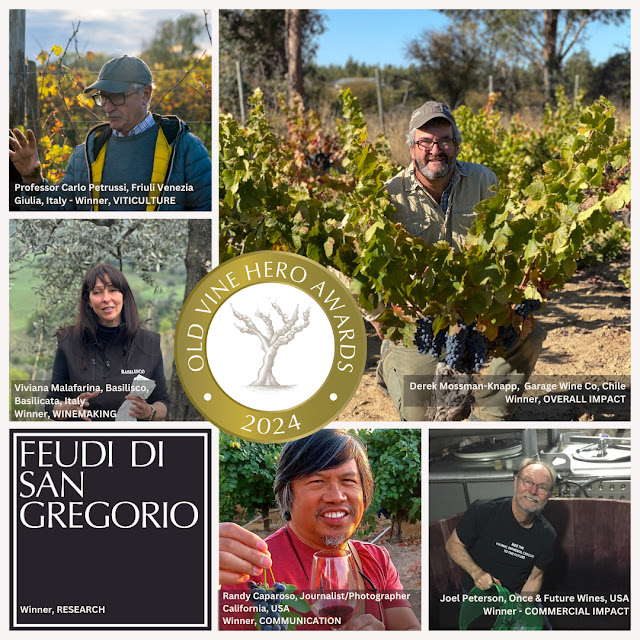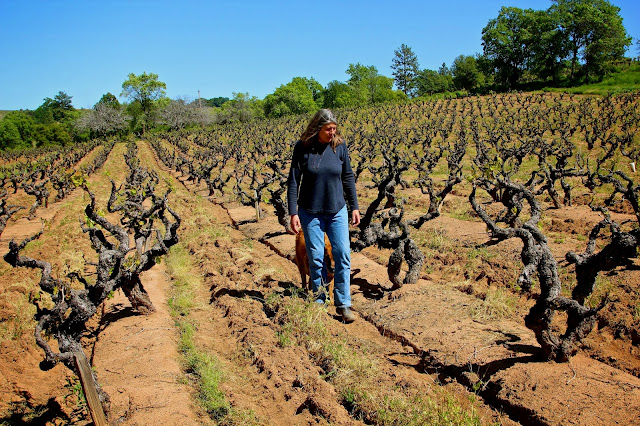The "Golden Rule" for communicating Old Vine benefits during the Old Vine Hero Awards presentation
 |
| The Old Vine Conference's 2024 Old Vine Hero recipients. |
Currin peppered me with questions in preparation for her on-air introduction. I was presented to the international online audience by Currin as the winner of the Old Vine Hero Award for Communication, alongside five other recipients recognized for their old vine research, viticulture, winemaking, overall impact and commercial impact.
During the webinar itself, of course, there was no time to cover all the material previously discussed with Currin. But I think it is worthwhile going over them, as they address the challenge of communicating the importance and benefits of old vines around the world—a phenomenon that is steadily shrinking (as opposed to growing, as we'd like it to be) as we speak.
 |
| View the entire 2024 Old Vine Hero awards webinar here. |
Our exchange:
Currin: Randy, can you tell us how you became obsessed with old vines, and then, in particular, the old vines of Lodi?
Caparoso: When I first visited Lodi 22 years ago [in 2002] I was struck by its Mediterranean climate and deep sandy soils, which reminded me of vineyards I'd seen in South-West France, a perfect environment for long-lived, healthy grapevines, especially Mediterranean varieties. I was not surprised to immediately learn that there are far more acres of old vines (in California, defined as vineyards planted between the 1800s and 1960s) in Lodi than anywhere else in the country. In 2010, I moved into a cottage in the middle of a 60-year-old vineyard of Zinfandel, growing on its own roots, and have been "stuck in Lodi" ever since.
Currin: What are the different powers and impacts of the many different media you use: paper (books, magazine), digital writing (blogs, online columns), audio (face-to-face speaking, podcasts) and visual (photography)?
Caparoso: It is necessary to keep speaking about old vine viticulture in public forums precisely because old vine wines still have a minority appeal among consumers; although slowly but surely, interest in the topic of "old vines" has been growing. Photography, in fact, is another key to journalism focused on old vines, which is mostly digital these days, although I have published a successful book [re Lodi!] touching on the subject.
.jpeg) |
| Tamlyn Currin of JancisRobinson.com. |
The crux of old vine plantings is that they have history. Wine lovers are naturally captivated by their stories as well as endless images of old vines, which seem to have the wisdom of age etched into their large, twisting trunks and spurs. It is the very robust physiology of old vines, which has a strong visual appeal, that gives them advantage in terms of long term grapevine health and enhanced ability to produce wines with stronger than average terroir expression. Generally speaking, the older the vine, the stronger their "sense of place" on a sensory level, which turns on wine lovers.
 |
| Classic ancient vine Mokelumne River-Lodi Zinfandel, planted on its own roots in 1915. |
Currin: Do you have a favourite medium? Is one easier to use than another? Is one more rewarding than another?
Caparoso: Books and print magazines are still important, but no question we are more easily able to reach more consumers, as well as more trade and media, through online articles, relayed through social media. Make no mistake, we are in a losing battle right now insofar as communicating the reasons why old vine wines should be appreciated, and old vine plantings better appreciated. We are losing thousands of acres as we speak. Therefore, any kind of medium that reaches wine lovers and the rest of the wine industry is a "best way" to celebrate old vines.
.jpeg) |
| Cover of Lodi!, depicting a downright ancient grapevine planted in 1889. |
Currin: Should we be weaving these platforms into each other?
Caparoso: Absolutely! I do traditional journalism and photography distributed primarily through online sites and blogs, but videos are another key to getting out the message. The people I work for, the grape growers belonging to the Lodi Winegrape Commission, have also been creating high production value videos telling the stories of old vineyards and the families who have been caring for them. In Lodi, families who have been doing this, for the most part, over 100 years. We are still losing more and more old vine blocks as we speak, but the more we can increase appreciation of them, the better.
Currin: What, for you, is the "golden rule" or "‘basic tenet" of communication–or rather, communication that drives change?
Caparoso: The "rule," if anything, is "tell the truth." Old vineyards and old vine wines speak for themselves. They do not need hype and should not require "high scores" to appeal to the consumers and industry. They go against the grain of how the wine industry largely operates today because they are real, they have historical significance, and represent the authenticity of terroir and appellations, which are still the base values of all the finest wines of the world. Old vines are an essence of why great wines have always had an enduring appeal.
 |
| The arduous task of picking old vine Lodi Zinfandel well over 100 years old. |
Currin: What will it take, do you think, to set unstoppable change in motion?
Caparoso: Keep fighting, organize locally, organize nationally, and organize internationally. It's really hard for small regional groups to even get started on this because it takes the energy, time and dedication of a few inspired individuals and, in most cases, a big budget. You're also fighting against convention because most wines sold today follow commercial constructs and marketing plans which don't require placing value on older vineyards.
Not to be critical, but the media, while captivated by old vines, is also not as cooperative as they could be. They'd rather publicize top brands, high scoring wines, and glamorize vintners and lifestyles, not so much creaky old vineyards. As my old friend Kermit Lynch once put it, it's all about "pop"—popular styles, popular tastes, wines that go "pop" or "bang-bang" in the mouth. Wines expressing old vine terroir end up being way down on the priority list of most media outlets.
 |
| Hand farmed and picked old vine Lodi Zinfandel, which needs to be appreciated for a specialness of each site in order to survive current market trends and rising costs of farming. |
In Lodi, we are continuously losing old vine plantings because of the steady drop in demand for those grapes for value priced wines such as White Zinfandel or $8 to $10 varietal reds and red wine blends. The older vineyards are just as susceptible to market trends as any other. The key to reversing that is to promote old vineyards as sources of premium priced wines, made by more handcraft vintners and appreciated for their sense of place—the specialness of each individual site.
But that doesn't happen overnight, although it can happen because most old vine plantings are quite capable of producing distinctive wines. Meanwhile, the cost of farming old vines, which has to be done by hand, is steadily rising; something very much part of the current crisis.
 |
| The author with Kermit Lynch, once upon a time in Ber-serkley, |
In any case, the world owes resounding gratitude to The Old Vine Conference for taking the initiative of tackling the issue of vanishing old vine viticulture on an international scale. But it will also take every country, every region, maybe every sub-region or community to make a concerted effort to bring attention to their own treasure trove of old vine plantings.
Old vines are disappearing because, simply, they are not appreciated enough. Communication will be a key to breaking this pattern!








Comments